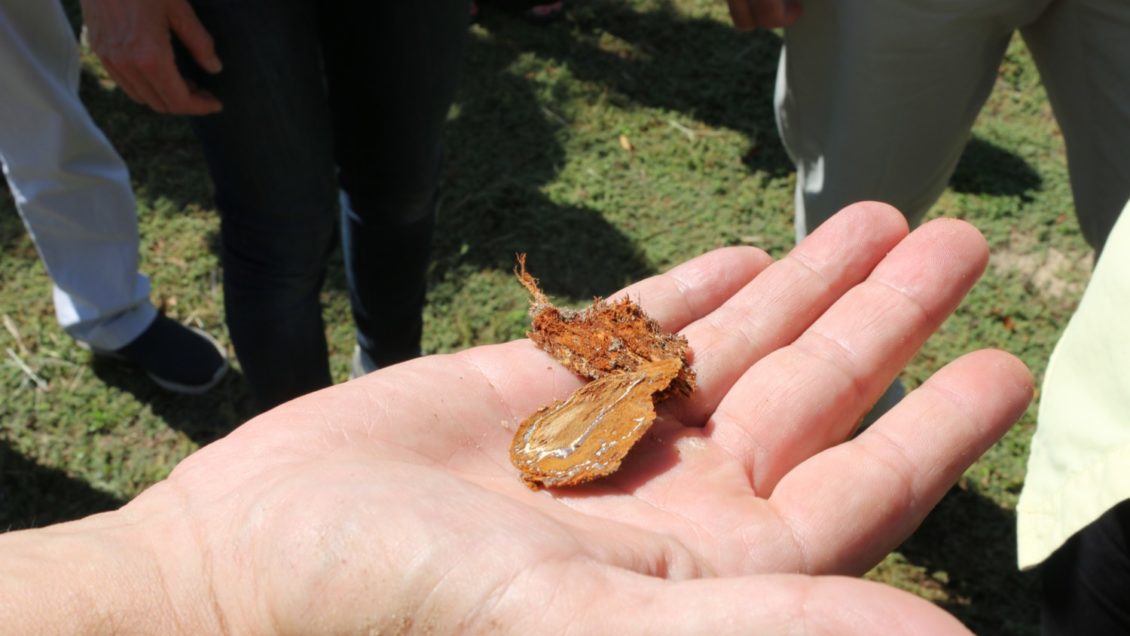
CLEMSON – Armillaria root rot is a devastating fungus that costs farmers millions of dollars in crop losses and for which there are no controls.
A group of experts and industry representatives from states where this fungus attacks almonds, cherries and peaches recently met to discuss a project designed to help farmers build a defense against this archenemy. The project is titled “Solutions to the Armillaria Root Rot Threat Affecting the U.S. Stone Fruit Industry,” and includes experts in breeding, genetics/genomics, plant pathology, plant physiology, horticulture, plant propagation and Cooperative Extension agents from Clemson University, University of Georgia, Michigan State University, University of Kentucky, the University of California-Davis and the United States Department of Agriculture’s Agricultural Research Service. During the three-day meeting, they met with peach growers and visited Armillaria-affected orchards at Titan Farms in Ridge Spring.
This multi-state project is led by Ksenija Gasic, a Clemson peach breeder and geneticist.
“Many researchers are studying Armillaria root rot, but they are not working together,” Gasic said. “Current management attempts are not working. This group will work together to find a solution to help growers in their fight against Armillaria root rot.”
Armillaria root rot, also known as “oak root rot,” is a soil-borne disease that occurs naturally in the majority of the United States. It is most often found on sites where trees have been cleared. This fungi attacks hundreds of vines, shrubs, shade and forest trees, as well as horticultural crops. It can remain dormant in the soil for many years, making infested land unsuitable for agricultural production of susceptible hosts for many years.
Current management attempts include biological and chemical controls, which are virtually ineffective and contribute a heavy chemical load to the environment. Cultural management practices include a technique developed by Clemson plant pathologist Guido Schnabel which involves planting peach trees in shallow engineered berms with the top parts of roots exposed above ground to extend the productive life of trees.
Other advances include the release of plum/peach hybrid rootstocks with a natural level of tolerance to Armillaria root rot, but these rootstocks are limited commercially due to the lack of vigor, dwarf tree size and small fruit size. At present, the only practical control practice is to avoid planting on land previously infested with Armillaria.
“We need to find genetic control for Armillaria root rot,” Gasic said.
Pratima Devkota is a postdoctoral researcher with Armillaria Root Rot Resistance Team at Michigan State University. She believes she can use her experience in tree root disease resistance screening to help find Armillaria root rot resistant or tolerant tree species or germplasm. She also believes working with other researchers will give her an opportunity to identify local biological control agents that can help control the Armillaria root rot problem.
“I understand how these species respond to Armillaria,” Devkota said. “I can help determine the ability of various germplasms or species to compartmentalize fungal growth, produce antifungal compounds, as well as allocate resources for plant growth.”
Daniel Kluepfel, a researcher with the United States Department of Agriculture at the University of California-Davis, explores plant and bacteria interactions at plants’ roots. Kluepfel said the effects of Armillaria root rot on California’s almond industry are devastating.

“We lose a large number of trees every year because of this fungus,” Kluepfel said. “It’s difficult to control. If a grower has it on their property, there’s not much they can do. It’s good to work together as a group. We all have expertise in different areas which complement each other and can help determine what can be done to help growers of crops affected by Armillaria root rot across the United States.”
In addition to the science of Armillaria root rot, the group also has members who can address the economics of the effects of this fungus. Tyler Mark, a University of Kentucky agricultural economist, is focused on determining how management changes impact farm finances. Mark’s plans include creating an economic model to understand how management decisions will affect growers.
Jason Rodgers, vice president of operations at Titan Farms, applauds this effort.
“We’ve always had oak root rot,” Rodgers said. “We inherited it when the farm was bought 23 years ago and, unless we can find a way to control it, we’ll pass oak root rot down to future generations. This research group is ideal. It’s one team working toward a common goal for everyone affected by this fungus.”
-END-
This planning meeting was funded by a United States Department of Agriculture National Institute of Food and Agriculture -Specialty Crop Research Initiative (SCRI) grant #2018-51181-28378. Any opinions, findings and conclusions or recommendations expressed in this material are those of the authors and do not necessarily reflect the view of USDA-NIFA.
Get in touch and we will connect you with the author or another expert.
Or email us at news@clemson.edu

